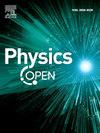Excellent self-assembly properties of Iron Phthalocyanines on alumina for locally ordered single-atom catalysts
IF 1.4
Q2 Physics and Astronomy
引用次数: 0
Abstract
In a biomimetic approach, metal Phthalocyanines (Pcs) can be considered to efficiently model single atom catalysts (SACs), hosting catalytically active single metal atoms in their macrocyclic cages. An ordered 2D array of SACs can thus be obtained when metal Pcs are assembled in a regular framework. In this work we consider in particular Iron Pcs (FePcs) on an ultra-thin alumina film grown on the Ni3Al(111) surface. Intrinsic modulations in the potential energy surface related with the oxide film structure drive the self-assembly of FePc molecules into a regular array, with molecular vacancies forming a hexagonal Bravais lattice with the same periodicity of the substrate, i.e. with a lattice parameter of about 4 nm. The symmetry of the supramolecular structure is dictated by the template rather than by the C4v symmetry of the individual molecules, thus indicating prevalence of molecule-substrate interactions with respect to intermolecular forces. The same hexagonal periodicity extends also to the multilayer, which starts forming already before completion of the first, interfacial monolayer. The latter exhibits a local definite chirality, also propagating to the multilayer in a determined stacking sequence.
酞菁铁在氧化铝上的自组装性能
在仿生方法中,金属酞菁(Pcs)可以被认为有效地模拟单原子催化剂(SACs),在其大环笼中容纳催化活性的单金属原子。因此,当金属pc在规则框架中组装时,可以获得有序的sac二维阵列。在这项工作中,我们特别考虑了在Ni3Al(111)表面生长的超薄氧化铝膜上的铁Pcs (FePcs)。与氧化膜结构相关的势能表面的固有调制驱动FePc分子自组装成规则的阵列,分子空位形成与衬底具有相同周期性的六边形Bravais晶格,即晶格参数约为4 nm。超分子结构的对称性是由模板决定的,而不是由单个分子的C4v对称决定的,因此表明分子-底物相互作用在分子间力方面的普遍性。同样的六边形周期性也延伸到多层,它在第一个界面单层完成之前就开始形成了。后者表现出局部确定的手性,也以确定的堆叠顺序传播到多层。
本文章由计算机程序翻译,如有差异,请以英文原文为准。
求助全文
约1分钟内获得全文
求助全文
来源期刊

Physics Open
Physics and Astronomy-Physics and Astronomy (all)
CiteScore
3.20
自引率
0.00%
发文量
19
审稿时长
9 weeks
 求助内容:
求助内容: 应助结果提醒方式:
应助结果提醒方式:


